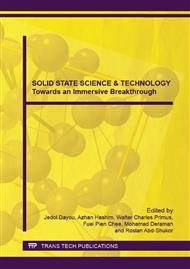p.45
p.53
p.59
p.67
p.73
p.79
p.85
p.91
p.96
Effect of Calcination Temperature on Metal Oxides and their Photocatalytic Activity
Abstract:
The effects of calcination temperature on the microstructures and photocatalytic activity of sol-gel synthesized TiO2, WO3, SnO2 and ZnO metal oxides were investigated. The synergistic effect of the phase structure, surface area, and crystallinity of the photocatalysts after calcination and on the photocatalytic activity was investigated. 1,2-dichlorobenzene (DCB) was used as a model contaminant in this study. The highest photocatalytic activity was obtained using TiO2 calcined at 900oC with large particle size, could be ascribed to the enhancement by the presence of defect site. Similarly, WO3 calcined at 900oC exhibited the best photocatalytic activity in the series of calcination temperature ranging from 400-1000oC. SnO2 calcined at 800oC showed the best photocatalytic activity while ZnO was found to give the lowest percent of DCB degradation. In this study, sudden increase in the surface area at higher temperature was correlated with the enhancement in the photocatalytic activity of each catalyst.
Info:
Periodical:
Pages:
73-78
Citation:
Online since:
June 2015
Price:
Сopyright:
© 2015 Trans Tech Publications Ltd. All Rights Reserved
Share:
Citation:


